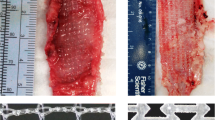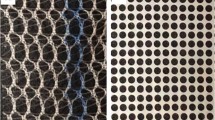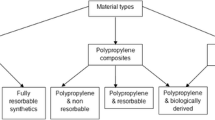Abstract
Introduction and hypothesis
To investigate the biomechanical effects of polyglecaprone fibers in lightweight meshes implanted into the vaginal and abdominal wall of parous rabbits.
Methods
New Zealand White rabbits (n = 24) were implanted with polypropylene meshes (32 g/m2), with (Prolift plus M, n = 12) or without (Prolift minus M, n = 12) polyglecaprone fibers. Following implantation in the posterior vaginal and abdominal wall, local side effects were evaluated and explants underwent uniaxial tensiometry after 120 and 180 days.
Results
The vaginal extrusion rate was at least 50 %, coinciding with a minimum of 20 % of contraction. There were no measurable effects of the addition of polyglecaprone on tensiometric strength and compliance in abdominal explants.
Conclusions
The addition of polyglecaprone fibers did not compromise the biomechanical properties nor did it prevent vaginal extrusion and contraction. The latter as well as some other limitations preclude the rabbit vagina to be a suitable model for biomechanical testing.

Similar content being viewed by others
References
Klosterhalfen B, Junge K, Klinge U (2005) The lightweight and large porous mesh concept for hernia repair. Expert Rev Med Devices 2:103–117
Klosterhalfen B, Klinge U, Rosch R, Junge K (2003) Long-term inertness of meshes. In: Schumpelick V, Nyhus LM (eds) In meshes: benefits and risks. Springer p 479
Epstein LB, Graham CA, Heit MH (2008) Correlation between vaginal stiffness index and pelvic floor disorder quality-of-life scales. Int Urogynecol J Pelvic Floor Dysfunct 19:1013–1018
Altman D, Vayrynen T, Engh ME, Axelsen S, Falconer C (2011) Anterior colporrhaphy versus transvaginal mesh for pelvic-organ prolapse. N Engl J Med 364:1826–1836
Maher CF, Feiner B, Decuyper EM, Nichlos CJ, Hickey KV, O'Rourke P Laparoscopic sacral colpopexy versus total vaginal mesh for vaginal vault prolapse: a randomized trial. Am J Obstet Gynecol 204:360. e1–360.e7
Fatton B, Amblard J, Debodinance P, Cosson M, Jacquetin B (2007) Transvaginal repair of genital prolapse: preliminary results of a new tension-free vaginal mesh (Prolift technique)—a case series multicentric study. Int Urogynecol J Pelvic Floor Dysfunct 18:743–752
Ozog Y, Konstantinovic ML, Werbrouck E, De Ridder D, Mazza E, Deprest J (2011) Persistence of polypropylene mesh anisotropy after implantation: an experimental study. BJOG 118:1180–1185
Ozog Y, Konstantinovic ML, Verschueren S, Spelzini F, De Ridder D, Deprest J (2009) Experimental comparison of abdominal wall repair using different methods of enhancement by small intestinal submucosa graft. Int Urogynecol J Pelvic Floor Dysfunct 20:435–441
Konstantinovic ML, Ozog Y, Spelzini F, Pottier C, De Ridder D, Deprest J (2010) Biomechanical findings in rats undergoing fascial reconstruction with graft materials suggested as an alternative to polypropylene. Neurourol Urodyn 29:488–493
Abramowitch SD, Feola A, Jallah Z, Moalli PA (2009) Tissue mechanics, animal models, and pelvic organ prolapse: a review. Eur J Obstet Gynecol Reprod Biol 144 [Suppl 1]:S146–S158
Abramov Y, Webb AR, Miller JJ et al (2006) Biomechanical characterization of vaginal versus abdominal surgical wound healing in the rabbit. Am J Obstet Gynecol 194:1472–1477
Abramov Y, Golden B, Sullivan M et al (2007) Histologic characterization of vaginal vs. abdominal surgical wound healing in a rabbit model. Wound Repair Regen 15:80–86
Pierce LM, Grunlan MA, Hou Y, Baumann SS, Kuehl TJ, Muir TW (2009) Biomechanical properties of synthetic and biologic graft materials following long-term implantation in the rabbit abdomen and vagina. Am J Obstet Gynecol 200(549):e1–e8
Pierce LM, Rao A, Baumann SS, Glassberg JE, Kuehl TJ, Muir TW (2009) Long-term histologic response to synthetic and biologic graft materials implanted in the vagina and abdomen of a rabbit model. Am J Obstet Gynecol 200(546):e1–e8
Huffaker RK, Muir TW, Rao A, Baumann SS, Kuehl TJ, Pierce LM (2008) Histologic response of porcine collagen-coated and uncoated polypropylene grafts in a rabbit vagina model. Am J Obstet Gynecol 198(582):e1–e7
Higgins EW, Rao A, Baumann SS et al (2009) Effect of estrogen replacement on the histologic response to polypropylene mesh implanted in the rabbit vagina model. Am J Obstet Gynecol 201(505):e1–e9
Li X, Kruger JA, Nash MP, Nielsen PM (2010) Anisotropic effects of the levator ani muscle during childbirth. Biomech Model Mechanobiol 10:485–494
Rubod C, Boukerrou M, Brieu M, Dubois P, Cosson M (2007) Biomechanical properties of vaginal tissue. I. New experimental protocol. J Urol 178:320–325, discussion 325
Haylen BT, Freeman RM, Swift SE et al (2011) An International Urogynecological Association (IUGA)/International Continence Society (ICS) joint terminology and classification of the complications related directly to the insertion of prostheses (meshes, implants, tapes) and grafts in female pelvic floor surgery. Neurourol Urodyn 30:2–12
Hilger WS, Walter A, Zobitz ME, Leslie KO, Magtibay P, Cornella J (2006) Histological and biomechanical evaluation of implanted graft materials in a rabbit vaginal and abdominal model. Am J Obstet Gynecol 195:1826–1831
Walter AJ, Morse AN, Leslie KO, Zobitz ME, Hentz JG, Cornella JL (2003) Changes in tensile strength of cadaveric human fascia lata after implantation in a rabbit vagina model. J Urol 169:1907–1910; discussion 1910
Walter AJ, Morse AN, Leslie KO, Hentz JG, Cornella JL (2006) Histologic evaluation of human cadaveric fascia lata in a rabbit vagina model. Int Urogynecol J Pelvic Floor Dysfunct 17:136–142
Bendavid R (2004) Recurrences: the fault of the surgeon. In: Schumpelick V, Nyhus LM (eds) In meshes: benefits and risks. Springer Verlag, Berlin, pp 51–62
De Tayrac R, Alves A, Therin M (2007) Collagen-coated vs noncoated low-weight polypropylene meshes in a sheep model for vaginal surgery. A pilot study. Int Urogynecol J Pelvic Floor Dysfunct 18:513–520
Ozog Y, Konstantinovic ML, Werbrouck E, De Ridder D, Edoardo M, Deprest J (2011) Shrinkage and biomechanical evaluation of lightweight synthetics in a rabbit model for primary fascial repair. Int Urogynecol J Pelvic Floor Dysfunct 22:1099–1108
Mirnajafi A, Raymer JM, McClure LR, Sacks MS (2006) The flexural rigidity of the aortic valve leaflet in the commissural region. J Biomech 39:2966–2973
Conflicts of interest
The authors receive unconditional grants form AMS and Ethicon. These companies did not interfere with the planning, execution or reporting of this experiment, nor are they the owner of the results. The authors have no financial interests in these companies.
Author information
Authors and Affiliations
Corresponding author
Rights and permissions
About this article
Cite this article
Ozog, Y., Mazza, E., De Ridder, D. et al. Biomechanical effects of polyglecaprone fibers in a polypropylene mesh after abdominal and rectovaginal implantation in a rabbit. Int Urogynecol J 23, 1397–1402 (2012). https://doi.org/10.1007/s00192-012-1739-6
Received:
Accepted:
Published:
Issue Date:
DOI: https://doi.org/10.1007/s00192-012-1739-6




